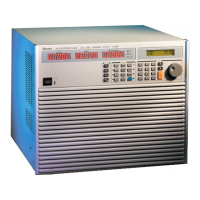x
Precautions before Use
1. The Electronic Load is for indoor use only.
2. The altitude up to 2000 meters is allowed to use the Electronic Load.
3. All specifications are tested under 20°C ∼ 30°C except stated
otherwise.
4. The range of operating temperature is 0°C ∼ 40°C.
5. The range of storage temperature is -5°C ∼ 60°C.
6. The operating relative humidity is from 30% to 90%.
7. The storage relative humidity is from 10% to 95%.
8. The transient overvoltage at Mains supply is 250V.
9. To meet the safety requirements, load wires must be thick enough
not to overheat while carrying the short-circuit output current of the
device connected to the electronic load.
10. The load module can be damaged by electronic discharge (static
electricity). Use standard anti-static work practices when handling
and installing the modules. Avoid touching the connectors and the
circuit board.
11. Ensure the load always receives adequate ambient cooling air at all
times and air filters, ducks, etc are maintained regularly. If loads
are used with a cabinet, precautions should be taken to minimize
heating within the cabinet.
12. If the UUT may be damaged or an unsafe condition may occur in the
event of a load short circuit (e.g. certain types of batteries), or if there
is no means of de-energizing the UUT in the event of a load failure,
user may consider including a suitably rated circuit breaker, fuse or
other means of disconnecting the load from the UUT under
emergency conditions.
13. When using Model 63208, 63209, 63210 and 63211 the distance
should be 1 meter for chassis front and 2.5 meters for rear without
any foreign object blocking the vents or the hardware temperature
may rise and cause OTP.
14. The electronic load can operate with a 115/230 Vac input as
indicated on the left of the Electronic Load. The 100/200 Vac line
voltage input model is used in Japan only. If the factory set switch on
this label that does not correspond to the local nominal line voltage,
turn off the Mainframe power and disconnect the power cord.
15. When connecting the load cable to the load module, do not use a
load cable to connect a load module and short circuit other load
modules, or it may cause the load cable to burn out when loading
larger current.
16. This equipment is not intended for performing measurements on

